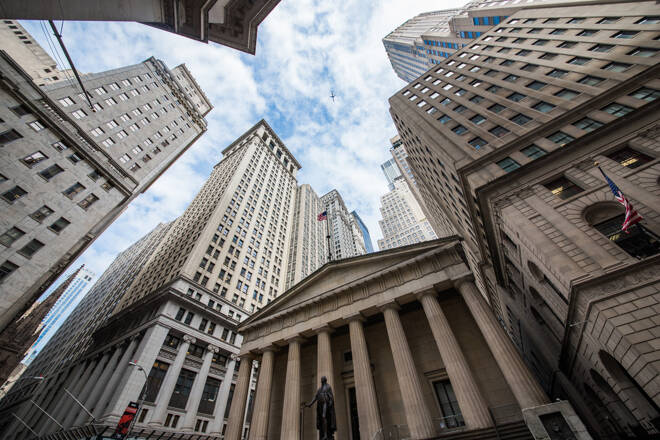Advertisement
Advertisement
Video Game Retailer GameStop Shares Sink Over 17% on Disappointing Third Quarter Revenue
By:
GameStop Corp. reported a loss for the third consecutive time in the fiscal third quarter as net sales plunged more than 30%, largely driven by store closures due to the COVID-19 pandemic and intense competition from rivals, sending its shares down over 17% in extended trading on Tuesday.
GameStop Corp. reported a loss for the third consecutive time in the fiscal third quarter as net sales plunged more than 30%, largely driven by store closures due to the COVID-19 pandemic and intense competition from rivals, sending its shares down over 17% in extended trading on Tuesday.
The videogame retailer said its net loss came down to $18.8 million, or 29 cents per share, from $83.4 million, or $1.02 per share, in the same quarter last year. Excluding items, posted a loss of 53 cents per share, analysts’ expectations were for a loss of 85 cents per share.
GameStop’s revenue slumped 30% to $1 billion, below the Wall Street consensus of $1.09 billion.
Following this disappointing result, GameStop’s shares slumped 17.36% to $14 in extended trading on Tuesday after closing 3.6% higher at $16.94. The stock is up about 180% so far this year.
Executive Comments
“We begin the fourth quarter with unprecedented demand in new video game consoles that launched in November, which drove a 16.5% increase in comparable-store sales for the month, despite being closed on Thanksgiving Day and the impact of COVID-19 related store closures, which affected most of our European footprint. We anticipate, for the first time in many quarters, that the fourth quarter will include positive year-on-year sales growth and profitability, reflecting the introduction of new gaming consoles, our elevated omnichannel capabilities and continued benefits from our cost and efficiency initiatives, even with the potential further negative impacts on our operations due to the global COVID-19 pandemic,” said George Sherman, GameStop’s chief executive officer.
“Overall, we remain confident in our strategy and look forward to executing in 2021 on the many exciting opportunities to leverage our brand, extensive loyalty member base, and increased digital capabilities to expand our addressable market and product offerings, providing growth in all things games and entertainment,” Sherman concluded.
GameStop Stock Price Forecast
Nine equity analysts forecast the average price in 12 months at $7.73 with a high forecast of $16.00 and a low forecast of $1.60. The average price target represents a -54.37% decrease from the last price of $16.94.
All those nine analysts, one rated “Buy”, five rated “Hold” and three “Sell”, according to Tipranks. Wedbush raised the target price to $16 from $8 and Telsey Advisory group upped the stock price forecast to $19 from $10.
Several other analysts have also upgraded their stock outlook. GameStop had its price target hoisted by analysts at Wedbush to $16 from $8. The firm currently has a “neutral” rating on the stock. Telsey Advisory Group upgraded to an “outperform” rating from a “market perform” and raised their price target for the company to $10 from $9. Benchmark boosted their price objective to $6 from $3.
Analyst Comments
“FQ3 was light vs. estimates but is a hop over in terms of sentiment. Nov comps +16% with mid-month new cycle launch was as expected. Significant SG&A savings of $316M YTD /$115M Q3 paired with pos. sales in Q4 should yield Y/Y profit growth. An announced shelf registration was unexpected, with $600M of Q3-end cash, inventories -33%, store closures with lease flex, e-com +257% Y/Y (18% of mix). Raising price target; waiting on clearer entry point & multi-year pathway,” noted Stephanie Wissink, equity analyst at Jefferies.
“Our forward sales assumptions are largely unchanged, with 1H21 estimate to grow 20%+ as demand for hardware outstrips supply. We trimmed Q4 profit on higher HW mix. Some degree of upside exists if tie-rates of software (physical; +digital for Xbox) are higher post-launch. We are monitoring: 1) pace of demand through the holiday, esp head-to-head allocation competition with Sony/Microsoft DTC; 2) channel mix & omni uptake; 3) PC gaming renaissance & related hard goods & software sales; 4) cost bend and lease flex; 5) CRM monetization. Price target to $15 on 5.5x FY2 EBITDA,” Wissink added.
Upside and Downside Risks
Upside Risks: 1) GME successfully shifts sales mix towards collectables, accessories, and digital. 2) Video Game Software declines at a slower rate than expected. 3) GME leverages the popularity of E-Sports to drive customers into locations. 4) Close locations that are a drag on margins. 5) 2022 EBITDA: $250M; Target Multiple: 5x; Price Target: $20 – highlighted by Jefferies.
Downside Risks: 1) Consumers adopt videogame downloads faster than anticipated. 2) Volatility in content related demand leads to sales decline in collectables. 3) Inventory and markdown risk. 4) Assumes investors only value GME on FCF and PPE; completely discounting CRM and equity value. 5) Sales deceleration across categories leads to deleveraging. 6) 2022 EBITDA: $120M; Target Multiple: 4.5x; Price Target: $10.
Check out FX Empire’s earnings calendar
About the Author
Vivek Kumarauthor
Vivek completed his education from the University of Mumbai in Economics and possesses stronghold in writing on stocks, commodities, foreign exchange, and bonds.
Advertisement
